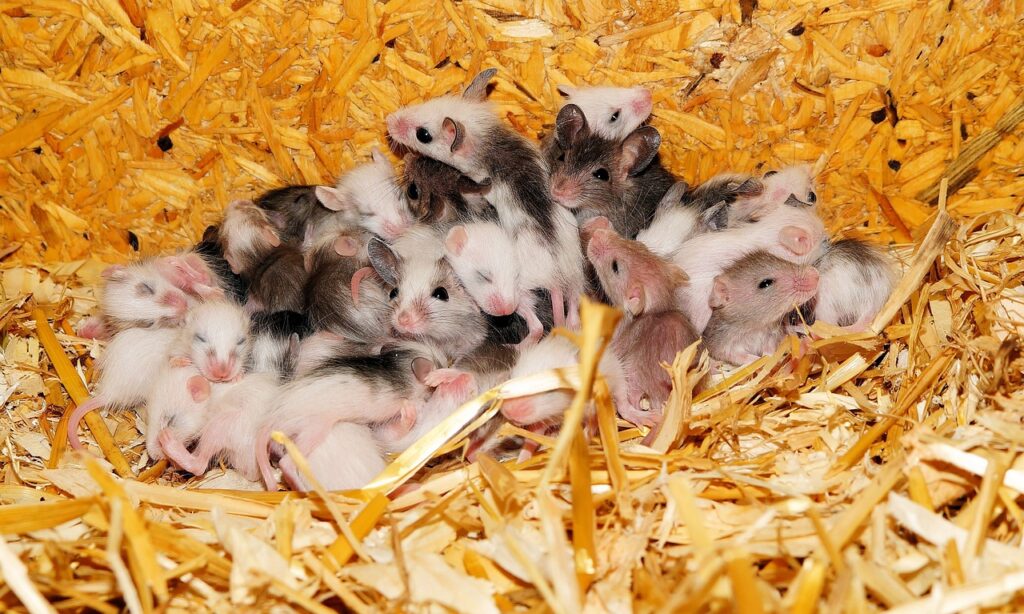Lesson1: genetics
Organisms that reproduce sexually have an advantage over organisms that reproduce asexually, because genes are shuffled from generation to generation. Asexually reproducing organisms can duplicate themselves, but the combination of genes will remain more or less stable. With a few exceptions, each individual in a population of sexually reproducing organisms has a distinct genetic composition. Meiosis is responsible for this variety. This is the basis of genetics as we know it.
1- Meiosis
Be careful, you need to see again your lesson about mitosis from last year to better understand what is following.
Meiosis (pronounced maɪoʊsɨs) is a special type of cell division necessary for sexual reproduction. In animals, meiosis produces gametes like sperm and egg cells, while in other organisms like fungi it generates spores. In many organisms, including humans, meiosis begins with one cell containing two copies of each chromosome—one from the organism’s mother and one from its father—and produces four gamete cells containing one copy of each chromosome. Each of the resulting chromosomes in the gamete cells is a unique mixture of maternal and paternal DNA, ensuring that offspring are genetically distinct from either parent. This gives rise to genetic diversity in sexually reproducing populations, which enables them to adapt during the course of evolution.
Meiosis begins when a cell’s chromosomes are duplicated by a round of DNA replication. This leaves the maternal and paternal versions of each chromosome, called homologs, with an exact copy known as a sister chromatid attached at the center of the new chromosome pair. The maternal and paternal chromosome pairs then become interwoven by homologous recombination, which often leads to crossovers of DNA from the maternal version of the chromosome to the paternal version and vice versa. A spindle fiber binds to the center of each pair of homologs, and pulls the recombined maternal and paternal homolog pairs to different poles of the cell.
The cell then divides into two daughter cells as the chromosomes move away from the center. After the recombined maternal and paternal homologs have separated into the two daughter cells, a second round of cell division occurs. There, meiosis ends as the two sister chromatids making up each homolog are separated and move into one of the four resulting gamete cells. Upon fertilization, for example when a sperm enters an egg cell, two gamete cells produced by meiosis fuse. The gamete from the mother and the gamete from the father each contribute half to the set of chromosomes that make up the new offspring’s genome.
Meiosis uses many of the same mechanisms as mitosis, a type of cell division used by eukaryotes like plants and animals to split one cell into two identical daughter cells. In all plants, and in many protists, meiosis results in the formation of spores, haploid cells that can divide vegetatively without undergoing fertilization. A few eukaryotes, like Bdelloid rotifers, have lost the ability to carry out meiosis and have acquired the ability to reproduce by parthenogenesis. Meiosis does not occur in archaea or bacteria, which reproduce via asexual processes such as binary fission.
2- Sex and genetic shuffling
Recombination introduces new gene combinations into populations.
- Humans have 23 pairs of chromosomes: one member of each pair was inherited from the mother and the other from the father. Correspondingly, we have two versions of every gene, one from the mother and one from the father.
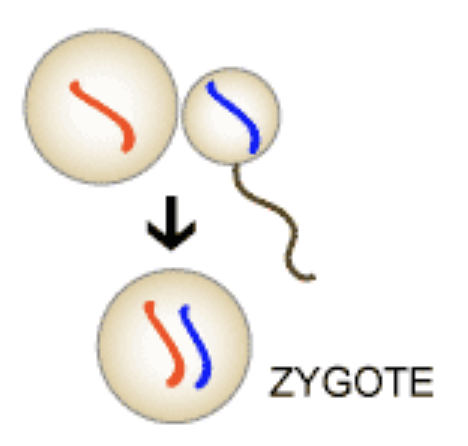
- If people reproduced by taking 23 pairs of chromosomes from the mother and 23 pairs of chromosomes from the father, the baby would have too many chromosomes (46 pairs). So eggs and sperm carry only half the usual number of chromosomes—just 23 unpaired chromosomes, carrying one version of each gene. When the egg and sperm get together (=fertilization), the baby receives the normal 23 matched pairs.
- When eggs and sperm are produced, the parent cell first copies each chromosome, leaving the duplicate pairs attached to one another.
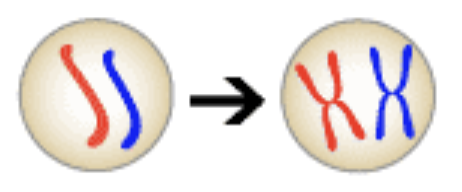
- Producing eggs and sperm is our first opportunity for mixing and matching genes. When the mother makes an egg, her chromosomes first find their matched partners and exchange some DNA with each other. That is calledrecombination. Because of this shuffling, genes from the mother’s mom and genes from the mother’s father can wind up next to one another on the same stretch of DNA. (The same thing happens in the father’s sperm.)

- Only after chromosomes recombine do they segregate randomly (shuffling) into different egg cells, so that each egg cell ends up with one version of each chromosome.
- Meiosis, step one:
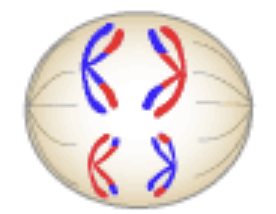
- Meiosis, step two:
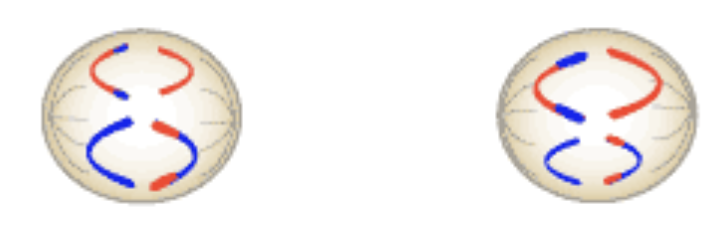
- When egg and sperm meet, the baby inherits a combination of genes that is totally unique: it carries versions of genes from all 4 grandparents plus any mutations that occurred when the mother and father were making the egg and sperm.
3- Patterns of Inheritance and Studying Crosses
Genes control what an organism looks like and there are many different variants of each gene. Fruit fly eyes can be red, white, scarlet, sepia, prune, maroon,or vermilion. Each of these many variants of a gene is called an allele. When you see fruit flies in a lab, though, you will notice that most of them have red eyes. They also have tan bodies, large flat wings, and other specific traits. This is because current fly research is largely based on the research done by T. H. Morgan in the 1920’s. Morgan happened to work in New York, and studied the kind of flies you might find living on overripe fruit in that area of the world. Because Morgan did so much work on these flies, they have become a sort of historical reference point that we use to this day. Any trait that corresponds to this reference point we call wild type. Any characteristic that differs from wild type is a variant or a mutant. Red eyes are wild type, and all those other colors are variants. Saying a trait is wild type doesn’t mean it is a better trait, and calling something a mutation doesn’t mean it is bad. Mutations lead to more diversity of traits. The terminology simply makes it easier for geneticists to understand each other – we are all using the same traits as a reference point.

This also allows us to use shorthand to refer to the different traits. A wild type trait is usually shown with a + sign. The mutant phenotypes are indicated by a letter or abbreviation. For example: white eye color is represented as w.
Alleles and how they work
Drosophila carry two copies of every chromosome, which means two copies of each gene. If the organism has two copies of the same allele, it is said to be homozygous. If it has one copy each of two different alleles, it is heterozygous. We write the genotype showing both alleles: a wild type is +/+. White eyed would be w/w.
If a mutant allele is dominant, a fly needs only one copy of the allele to show the phenotype. Usually in english, this mutant is represented by a capital letter. Curly wings, Cy, is a dominant allele. If the mutation is recessive, a fly needs to have two copies of the allele, one on each chromosome, to develop the phenotype. Eyeless, ey, is a recessive allele that results in very small eyes.
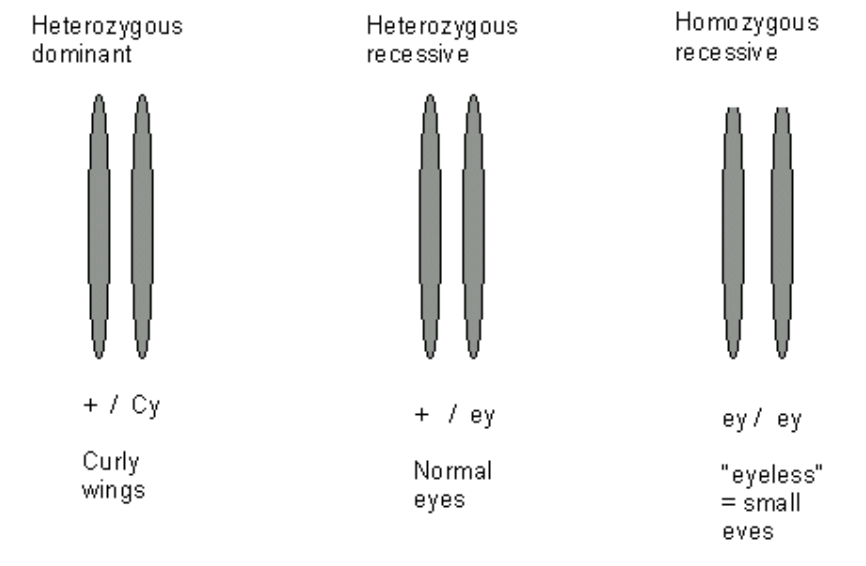
Knowing whether a trait is recessive or dominant can be very important. If a pregnant woman has a rare disease, she will want to know whether she will pass it on to her child or not. You can’t know just from looking whether a certain trait is recessive or dominant. In humans it is sometimes very difficult to determine; it is necessary to look at elaborate family trees for several generations of one family to find the patterns of inheritance.
In fruit flies it is much easier because we can set up controlled crosses in which we mate flies of known genotypes. The numbers of their offspring with certain phenotypes informs us of how the trait is inherited.
Some more terms you should know before doing crosses:
P = parental generation, the parent flies we mate in the cross.
F1 = the first generation of offspring
F2 = the second generation. There can be an F3, F4, etc.
Progeny = offspring, the children of the parents.
To go further:
Gregor Mendel and the Principles of Inheritance: Excellent website!
https://www.nature.com/scitable/topicpage/gregor-mendel-and-the-principles-of-inheritance-593

